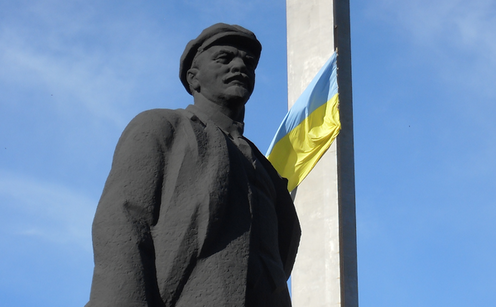Vladimir Putin has long insisted Ukraine is part of the country he rules. “Kiev is the mother of Russian cities. Ancient Rus is our common source and we cannot live without each other,” he wrote in March 2014 – a few days before completing the annexation of Crimea. The Russian president returned to this theme in an essay on the Kremlin’s website in July 2020 when he wrote, “True sovereignty of Ukraine is possible only in partnership with Russia.”
Seven months later, Putin has doubled down on this idea. In an hour-long and fairly wide-ranging speech on February 21, he repeated that “Ukraine is not just a neighbouring country for us. It is an inalienable part of our own history, culture and spiritual space.” He repeatedly denied Ukraine’s right to independent existence – and, at times, that the country exists at all as an independent entity. Instead he appeared to accept the unity of the two countries as historical fact.
In doing so, he revealed the structures of an imperial ideology with a chronology and ambition that goes far beyond post-Soviet nostalgia to the mediaeval era. But to what extent is that ideology shared by Russians?
One of the striking elements of Putin’s latest speech about Ukraine, which accompanied the recognition of Donetsk and Luhansk as independent states, was his insistence that Ukraine exists as a by-product of Russian history, insisting that “Since time immemorial, the people living in the south-west of what has historically been Russian land have called themselves Russians and Orthodox Christians.”
À lire aussi :
How Russian is Ukraine? (Clue: not as much as Vladimir Putin insists)
But he later undercut his insistence of these shared origins, stating that “Modern Ukraine was entirely created by Russia or, to be more precise, by Bolshevik, Communist Russia.” To him, the making of modern Ukraine only started “after the 1917 revolution”, and Ukrainians have “Lenin and his associates” to thank for their state. This was a reference to Lenin’s creation of a federation of Soviet states, the USSR, out of the ethnic diversity of the former Russian empire.
In reality, Ukrainian aspirations for statehood predated revolution by at least two centuries. From the Ukrainian Hetmanate’s 1710 Bendery Constitution to the 1917 establishment of the West and Ukrainian People’s Republics and appeals at the Paris Peace Conference for status, Ukrainians have continuously asserted themselves as a distinct people.
The formation of the USSR was, in part, conditioned by the previous creation of these two independent Ukrainian Republics in the aftermath of the revolution and the disintegration of the Austro-Hungarian Empire. These republics stemmed directly from the 19th century Ukrainian romantic national movement that reassessed the impact of the Cossack past, fuelling the development of an identity centring on a distinct language, culture, and history.
When the Bolsheviks, Lenin at their head, took control over the Ukrainian territories, the idea of Ukraine as an independent nation could not be ignored, and led to the independent status – on paper – of the Ukrainian Soviet Republic in 1922.
What Putin’s address reveals is the desire to plot Russian and Ukrainian history through the lens of imperialism. He is attempting to establish a direct line from shared ancient origins to a first and second Russian empire: one under the Romanov Tsars (1721-1917) and the second as part of the USSR.
Across those two imperial epochs, Ukraine is reduced to a tributary state and mentions of national aspirations are smothered. This is precisely the message that the Kremlin continues to disseminate in the 21st century.
A lack of popular appetite
But what does the Russian public believe? Three decades ago, when the USSR collapsed, only rare and often ultra-nationalist politicians resorted to imperial history in imagining Russia’s post-soviet future. As early as the 1990s, ultra-nationalist politician Vladimir Zhirinovsky advocated ceasing coal supplies to Ukraine as a tactic to bring back Russia’s lost territories, but he remained a fringe figure in Russian politics.
Still, in 2011 and 2012 Global Attitudes surveys conducted by Pew Research Centre, support for imperial ideology was not insignificant. When asked whether “it’s natural for Russia to have an empire”, only 31% of Russian respondents disagreed. Whether nostalgia for empire translates to appetite for war to “regain territory” remains unclear.
It is impossible to paint all Russian perceptions of Ukrainians with the same brush. Russian feelings toward their neighbour have historically ranged from genuine feelings of brotherhood and warmth to virulent expressions of xenophobia manifesting in episodes of ethnic cleansing, such as the 1932 orchestrated famine known as the Holodomor.
But when it comes to the question of how Russia should position itself with regards to claiming eastern Ukrainian provinces as long-lost parts of the “Russian empire”, opinion is more clearly divided. Only 26% of Russians wanted the Donbas to become part of Russia, while 54% are in favour of varying forms of independence (within Ukraine or separate). War remains an unpopular choice, with only 18% of Russians unreservedly supporting armed conflict in defence of the two breakaway republics in a poll from April 2021.
Post-Soviet neo-imperialism
Ultimately, the use of “empire” as an ideology reveals Russia’s yearning for – or sense of entitlement to – a third imperial regime. The rhetorical and physical erasure of Ukrainian history and identity makes it much easier to assert claims of shared Russian heritage. This will be important to bear in mind as we watch the development of this renewed conflict over Ukraine.
Parallels with other formerly colonised peoples abound. But, as Kenya’s envoy to the UN put it, no matter what conditions presided over the drawing of modern borders, “we must complete our recovery from the embers of dead empires in a way that does not plunge us back into new forms of domination and oppression.”
![]()
Olivia Durand receives funding from Freie Universität Berlin. She is a research associate of the Institute for Historical Justice and Reconciliation. This article was written with the assistance of Katria Tomko, a Research Associate at the Institute for Historical Justice & Reconciliation.











